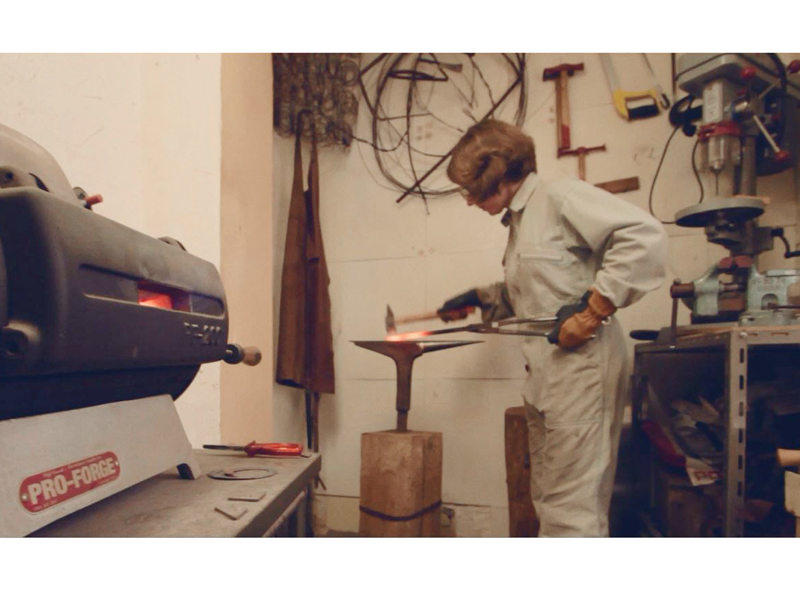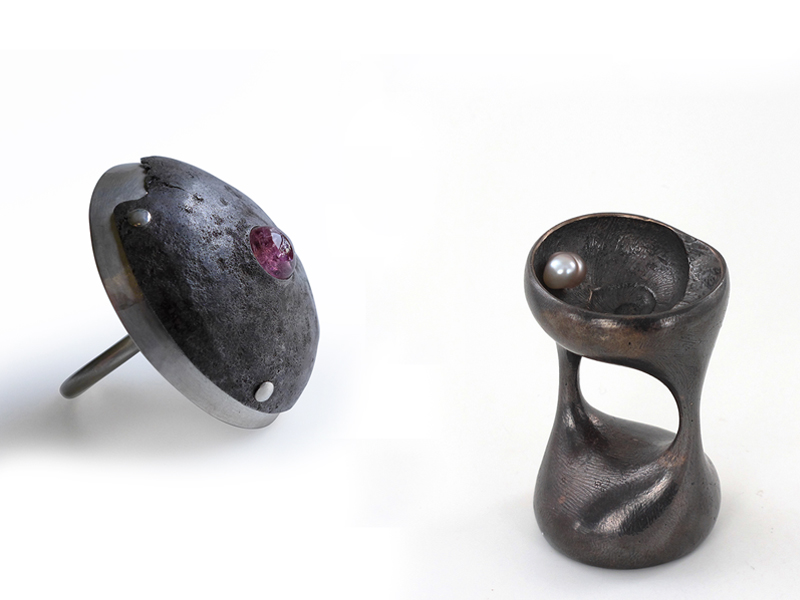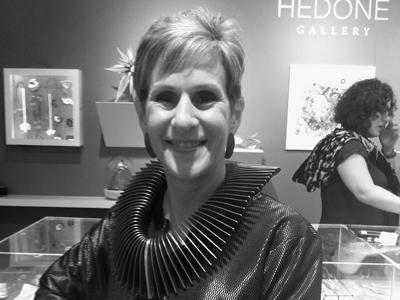
French jewelry artist Marianne Anselin prefers iron, rusted patinated steel, and cast iron as her materials of choice, forging them into detailed impressions of leaves, shells, and other shapes borrowed from nature. Inspired by walks in the woods, she transforms found objects into jewels with strong features, making statements about nature, materiality, preciousness, and the fragility of life. Here she talks about her work and first major solo exhibition, Touching Iron, at Galerie Elsa Vanier in Paris.
Bonnie Levine: Tell us about your background and how you became interested in making jewelry.
Marianne Anselin: It is all about encounters, which is normal as I feel that jewelry is a social object. Very early on, I was interested in anthropology, sociology, and art. Moreover, I was always making things with my hands. When I was young, I happened to meet some jewelers, and, after high school, I started making jewelry. I found that I loved it, so I looked for an apprenticeship.
You’ve studied with some important makers, namely Gilles Jonemann, Esther Brinkmann (HEAD Genève), and Sophie Hanagarth. How have they shaped and influenced your work? What major lesson did you learn from each of them?
Marianne Anselin: I had several masters, since this also comes down to encounters, and one thing leading to the next…
The three masters you mentioned helped me in discovering who I was, in finding out what I cared for and in developing my sensitivity as well as my own language. I cannot say what I specifically kept from each one, but their major input was that one needs to work hard and learn to listen.

I’m curious how you became interested in forging as a technique. It seems very physical and demanding, not to mention hot and noisy. What do you achieve through forging that’s different from more traditional jewelry techniques?
Marianne Anselin: I started to forge in college. I loved to work with metals and I liked to challenge myself, without looking for the easy way out. For a long time, I thought that this was the reason why I liked forging. But in fact, forging is like walking: it’s a physical action with a beat, demanding all your attention, requiring that you let go. Indeed, noise and heat amplify this fact. As far as I am concerned, forging also means using all the mechanical properties of metal. Bending it, making it longer, or compressing it… Since this is not a technique that I master entirely, forging leaves some freedom to the material and sometimes the metal leads me. I then observe what happened and take it further…
Your current show, Touching Iron, at Galerie Elsa Vanier, is your biggest monographic show to date. Can you tell us how long it was in the making, what the concept for the exhibition was, and what new work you are presenting? Do you have a favorite piece?
Marianne Anselin: In reality, the French title for the show is J’Empreinte, a neologism that plays on the double meaning of “borrowing” and “making an imprint.” This wordplay speaks to a general aspect of my work: borrowing from nature or from mankind and taking imprints of shapes that touch me. In French, we can play with those two concepts because they are pronounced the same but spelled differently. “I borrow” is “J’emprunte,” and “imprint” is “empreinte”…
The new creations kept me busy for half a year, but I also wanted to share my vision of jewelry so I created a scenography to show earlier works. Some one-off pieces have been lent by collectors and I insisted on putting creation dates in the showcases, so by looking at the whole exhibition you get a meaningful story, and conversations between pieces across time—or so I hope, anyway.
Most of the new pieces created for this exhibition were the result of imprints of natural elements. But I have been selecting details and I have created new shapes by bending them and putting them together. From an idea to the piece of jewelry, the process is fairly long and requires many steps. Some processes, like natural patinas, cannot be controlled.
I don’t have a favorite piece, even though I have a particular feeling for some. But I like a piece to look “obvious” and to stay fairly open to somebody’s own interpretation.

Your jewelry looks like detailed, intricate imprints of nature, incorporating objects that you find on walks in the woods. Is this where your inspiration comes from? Do you know what are you looking for, or do you know it when you see it? What kind of items do you collect?
Marianne Anselin: Inspiration derives from encounters. Some detail, shape, or material can attract my eyes and appeal to me. I immediately know what I could try to make of it. This could happen while traveling or during a walk, for example. For some specific materials, I know where to find them so I also go to familiar places when I need them.
I am particularly fond of discarded steel pieces which have almost turned natural after suffering years of bad weather. I have a strange habit of spotting anthropomorphic shapes in them and I have a whole collection in my workshop!

You prefer iron, rusted steel, and discarded objects as your materials of choice. Are you making a statement about the preciousness of jewelry and the concept of value?
Marianne Anselin: It is rather a question of perspective on life: For me, something precious does not necessarily have a market value. A piece of jewelry is something so particular that it cannot be reduced to its exchange value. Sometimes, an essential element can be hidden by something more visible just because it sparkles. I am attracted by used materials and I integrate them [into my work] since they are a metaphor of our fragility and of how short life is and, therefore, of what is essential.
Recently, you started integrating precious or nonprecious details—seeds, pearls, opals—into your iron work. Is that a new direction for you? How is that redefining what you consider “precious”?
Marianne Anselin: I just work with materials I am fond of. They can be contrasting and I am interested in reuniting, setting up, and creating coincidences. Such investigations or surprises are precious. I am not interested in using a gemstone just for the sake of it. When I integrate two materials such as emeralds in cherry-tree branches or keshi pearls in my snail iron imprints, it is because I felt it necessary. It must look “obvious,” underlining a meaning or a shape.

You’ve said that nature and the studio are your workplaces, where transformations of materials take place. Can you elaborate on this?
Marianne Anselin: I cannot just work in the workshop … the outside world, and especially nature, is part of my creation process. I research while walking; I start a piece. Outside, I observe, I manipulate, I collect, I sometimes draw, I discover. In the workshop, I rediscover by handling raw materials differently, with techniques and tools.
I’ve read that your jewelry is said to have a soul and inspires subtle poetry. What does this mean? Do you agree with it?
Marianne Anselin: I am delighted if my work can be inspiring. I do not create jewelry for me, but for other people. I always try (but don’t always succeed) to leave space for imagination. If my jewelry inspires poetry, I am very touched, as my ideal is to create beautiful, enjoyable things.

What’s next for you? Will you be taking part in the forthcoming Parcours Bijoux[1], planned for 2017? Do you have other plans in store?
Marianne Anselin: When the exhibition is finished, some pieces are expected in New York at Françoise Klein, then in Lille at Galerie Bettina Flament, and I hope in Berlin (at Michaela Binder).
Of course I have plans for next year’s Parcours Bijoux! On the one hand, I am taking part in the event’s organization. On the other hand, I have been selected by Elsa Vanier for an exhibition called Titanesque with nine other jewelers showing jewelry using titanium as a main component. This will be a new challenge for me. Finally, I also intend to collaborate with Valentine Herrenschmidt, another jewelry artist.
In the meantime, I will work again on a series called Mechanics. I like to put the occasional series on hold and come back to them later with a fresh mind.
What have you seen, read, or heard lately that made an impact on you that you’d like to share with our readers?
Marianne Anselin: Lately, I have been reading Giuseppe Penone’s book Le Regard Tactile (which translates roughly as “a tactile gaze”), conversations with Françoise Jaunin. His works make me ask questions, I find them both beautiful and sensitive. We share a fondness for the same materials, the ones that link man’s body to nature.
Thank you.
Prices of work in the exhibition range from €690 to €3,880 (roughly $748 to $4,208).
INDEX IMAGE: Marianne Anselin, Ressort et Graine, 2011, necklace, patinated iron, red seed from South America, 600 mm long, photo: Elsa Vanier

VERSION FRANÇAISE
Bonnie Levine: Parlez-nous de votre parcours, et de comment vous vous êtes intéressée à la fabrication de bijou.
Marianne Anselin: C’est une histoire de rencontres et d’ailleurs le bijou est un objet social. Très tôt je me suis intéressée à l’anthropologie, la sociologie, l’art… Et j’ai toujours fait des choses avec mes mains. Quand j’étais jeune, j’ai rencontré des bijoutiers et après avoir suivi un parcours général, j’ai commencé à faire des bijoux; comme cela m’a plu, j’ai cherché un apprentissage.
Vous avez étudié avec des créateurs importants, en particulier avec Gilles Jonemann, Esther Brinkmann (HEAD Genève) et Sophie Hanagarth. Comment ont-ils guidé et influencé votre travail? Quelle leçon avez-vous retenue de chacun d’entre eux?
Marianne Anselin: J’ai eu plusieurs maîtres car c’est aussi une histoire de rencontres, de suite logique…Ils m’ont tous les trois aidés à me découvrir, à trouver ce que j’aimais, à développer ma sensibilité et mon langage. Je n’ai pas retenu une leçon propre à chacun d’eux; la leçon majeure est qu’il faut travailler et savoir écouter !
Je suis curieuse de savoir comment vous êtes arrivée à la technique de la forge. Ça semble très physique et exigeant, pour ne pas dire chaud et bruyant. Que vous permet la forge, qui serait différent d’autres techniques plus traditionnelles liées au bijou?
Marianne Anselin: J’ai commencé à forger pendant mes études; j’aimais travailler le métal auquel il fallait me confronter, ne pas chercher la facilité. J’ai longtemps cru que c’était pour ça que j’aimais forger. En vérité, la forge est comme la marche, c’est un acte physique rythmé qui vous demande toute votre attention, qui vous oblige à relâcher votre pensée et en effet, cela est amplifié par le bruit et la chaleur. Forger, c’est aussi pour moi, utiliser pleinement les propriétés de la matière métallique : la déformer, l’allonger, la rétreindre… Comme c’est une technique que je ne maîtrise pas complètement, cela laisse aussi une part de liberté à la matière; parfois c’est elle qui me guide: j’observe ce qu’il s’est passé et je la pousse plus loin formellement.
L’exposition qui vient de se terminer chez Elsa Vanier, « J’Empreinte », est votre plus importante exposition monographique à ce jour. Combien de temps le projet vous a-t-il pris, quel est le concept derrière l’exposition, et quel nouveau travail avez-vous présenté? Avez-vous une pièce favorite?
Marianne Anselin: L’exposition s’appelle « J’empreinte », un mot inventé qui joue sur un double sens, l’emprunt et l’empreinte. Ce mot permet de parler de mon travail en général : emprunter à la nature ou à l’homme tout en évoquant mes dernières recherches qui sont littéralement des empreintes de détails d’éléments naturels. J’avais envie de montrer l’ensemble de mon univers. Pour cette exposition, j’ai créé une scénographie, permettant un peu d’entrer dans mon univers, au sein de la galerie… Un lieu dans le lieu…. J’ai tenu à mettre les dates de création sur les cartels afin que les objets soient situés dans le temps, permettant de projeter une suite logique, une correspondance et donc l’ensemble d’une histoire.
Dans mes derniers travaux je m’attache à « prendre » certains détails dans la nature et à créer des formes en les assemblant et en les déformant. Le processus de création, de l’idée au bijou fini, est très long et requiert beaucoup d’étapes. Certaines, comme des patines réalisées par le temps par exemple ne sont pas maîtrisables.
Je n’ai pas de pièce favorite; il y en a bien sûr que je préfère à d’autres et certaines appellent à une exploration plus approfondie. J’aime quand une pièce paraît évidente et laisse la place à une libre interprétation.
Vos bijoux ressemblent à des empreintes détaillées et complexes de la nature, qui incorporent des objets trouvés lors de marches dans les bois. Votre inspiration vous vient-elle de ces ballades? Savez-vous ce que vous recherchez avant de partir, ou vous décidez-vous au fil de vos pérégrinations? Quel genre de choses ramassez-vous?
Marianne Anselin: L’inspiration naît en effet de ces rencontres: des détails, une forme ou une matière qui arrête mon regard, qui me séduit. Souvent, je sais tout de suite ce que je vais essayer de fabriquer avec cette rencontre, cela se passe en voyage ou au cours d’une ballade par exemple. Je vais aussi chercher certains matériaux à des endroits précis, dans des lieux qui me sont familiers quand j’en ai besoin pour réaliser une idée.
J’adore particulièrement certains éléments industriels en acier qui redeviennent naturels avec le temps et les intempéries. Je suis particulièrement attirée par des formes, qui sous mon regard anthropomorphique, se transforment en parties du corps humain.
Vous considérez le fer, l’acier rouillé et les objets jetés comme vos matériaux de prédilection. Est-ce une manière de prendre position par rapport à la préciosité du bijou, et au concept de valeur?
Marianne Anselin: C’est plutôt un regard sur la vie : ce qui est précieux n’a pas forcément une valeur marchande. Le bijou est un objet tellement particulier qu’il ne peut pas être réduit à une simple valeur monétaire. Et parfois l’essentiel est caché par des choses très visibles parce ce qu’elles brillent par exemple.
Je suis attirée par des éléments usés et je travaille avec parce qu’ils m’interpellent parce qu’ils me rappellent notre fragilité, le coté éphémère de la vie et donc ce qu’il y a d’essentiel.
Récemment, vous avez commencé à incorporer des détails précieux et non précieux – graines, perles, opales – dans vos pièces de forge. Est-ce une nouvelle direction? Cela redéfinit-il ce que vous considérez comme “précieux”?
Marianne Anselin: Je travaille avec les éléments qui me plaisent, ils sont parfois opposés et cela m’intéresse justement, réunir, jeter des ponts, créer des coïncidences. L’interrogation, la surprise sont précieuses. Je n’utilise pas une pierre juste pour mettre une pierre, cela ne m’intéresse pas.
J’essaye, lorsque je réunis deux matières, que ce soit une évidence; comme les émeraudes dans les débuts de branches de cerisier ou les perles keshi dans les empreintes d’escargot. Cela souligne un sens ou une forme.
Vous avez dit que la nature et l’atelier sont vos lieux de travail, où a lieu la transformation des matériaux. Pouvez-vous nous en dire un peu plus?
Marianne Anselin: Je ne peux pas travailler juste dans l’atelier; l’extérieur et surtout la nature font partie pleinement de mon processus de travail: j’y fais mes recherches, le début d’une pièce.
Dehors, j’observe, je manipule, je collecte, parfois je dessine: je découvre. A l’atelier, je redécouvre en manipulant autrement avec des techniques et des outils.
J’ai lu que vos bijoux semblent avoir une âme, et inspirent une subtile poésie. Ça veut dire quoi? Êtes-vous d’accord?
Marianne Anselin: Je suis ravie si mon travail peut inspirer du beau aux autres ! Je ne crée pas des bijoux pour moi mais pour les autres. J’essaye et ce n’est pas toujours réussi, de laisser de la place dans l’objet à l’imagination. Si les bijoux que je fabrique inspirent de la poésie je suis flattée bien entendu mais surtout cela répond à un idéal: contribuer à créer des choses belles et agréables.
Qu’est-ce qui vous attend dans les mois qui viennent? Allez-vous participer au prochain Parcours Bijoux, prévu en 2017? Avez-vous d’autres projets?
Marianne Anselin: Certaines pièces de l’exposition vont partir pour la fin de l’été à New York chez Françoise Klein, puis à Lille (Galerie Bettina Flament) et j’espère peut être à Berlin (Galerie Michaela Binder).
Bien sûr, j’ai des projets pour le Parcours Bijoux 2017 qui aura lieu à Paris !
D’une part, je participe à son élaboration. D’autre part la galerie Elsa Vanier a proposé une exposition sur le titane, les particularités de ce métal m’interpellent. Enfin, je travaille actuellement sur un projet collaboratif avec l’artiste Valentine Herrenschmidt (sculpteur calligraphe).
J’ai l’intention de retravailler sur la famille des mécaniques, j’aime mettre en suspens certaines familles de bijoux pour me permettre d’y revenir avec fraicheur.
Qu’avez-vous vu, lu ou entendu récemment qui vous a marqué, et que vous aimeriez partager avec nos lecteurs?
Marianne Anselin: Beaucoup de choses car j’aime voyager, voir des expositions et lire…Dernièrement, les réflexions de Guiseppe Penone dans le livre « Le regard Tactile ». Son travail m’interpelle, je le trouve beau et sensible. Il travaille avec des matériaux qui me touchent et il parle du lien entre nature et corps humain.

[1] The Parcours Bijoux, in its second edition, is a city-wide jewelry exhibitions and conferences extravaganza that will take place in Paris, between October 1 and November 15, 2017. It will feature around 30 exhibitions, dotted around the city. http://dunbijoualautre.com/parcours-bijoux-2017-en/




